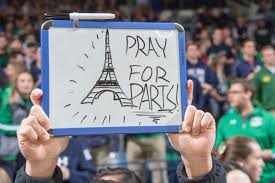Today in the Gospel from Mark, chapter 13, Jesus is talking to a group of disciples who are looking around at the magnificence and splendor and stability of the temple buildings. Jesus tells them to not look to those earthly vessels and creations for confidence or security or hope. As a matter of reinforcing His lesson He tells them that not one single stone of that huge, beautiful temple will be left standing upon another, something which came to fulfillment in the year 70A.D. when Rome completely sacked and destroyed Jerusalem after they tried to rebel, and something which still holds true to this day. He tells them about wars, rumors of war, famines, earthquakes, and various persecutions and martyrdoms.
Life hasn’t changed much although things seem to be getting worse and worse. The people of Paris woke up to some sad realities and probably believe that their world came to an end. But as the old saw says, “life does go on”. It does until it ends. The message of the Bible is that here we have no lasting city and the only thing that we can count on is God’s mercy in Christ. The forgiveness of sins is too narrow for us. We need the understanding that we try to get into the heads of our confirmation students. – where there is the forgiveness of sins there is life and salvation.
Even today, separated by history and language, one cannot read a Luther sermon without being brought to a point where you realize that here is someone who “gets it” and wants you to get it too. In fact one of Luther’s constant points in preaching is to explain to others that they are surrounded by others who don’t get it. He brings his hearers into a group that know something others don’t and he makes them want to make it known. Here is a portion of Luther’s sermon on Matthew 18 – “they do not know what forgiveness of sin is, and think it is something that sticks in the heart and lies still there, whereas it is the whole kingdom of Christ, which lasts forever without end. For as the sun shines and gives light none the less, although I close my eyes, so this mercy seat or forgiveness of sins stands forever, though I fall. And as I see the sun again as soon as I open my eyes, so I have the forgiveness of sins again when I look up and again come to Christ. Therefore we must not make forgiveness so narrow, as the fools dream.” Luther is being very personal here, and yet he explains a personal experience of what is a universal truth. There is nothing abstract here. He is not standing outside and explaining a function of nature or standing outside and narrating a script and drama, but standing outside himself and explaining what God’s history has done for all through the background of what God has done to and for him. That is why Luther could change the old funeral dirge, “in the midst of life we are surrounded by death”, to “in the midst of death we are surrounded by life in Christ”.
The pain of the French nation is real and personal and historical. The pain and fear that we all suffer is real and personal. The eyes of faith see the work that God performs in the world as for our good and ultimate salvation. Reliance on Christ as Savior is a reaction to His promises. Jesus prepared those disciples for all the awful things that would happen to Him and them. They were still unprepared until He opened their eyes to see the vast plan of God working through their history and His grace.


